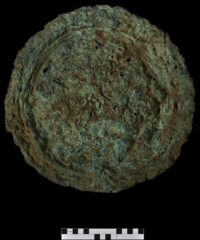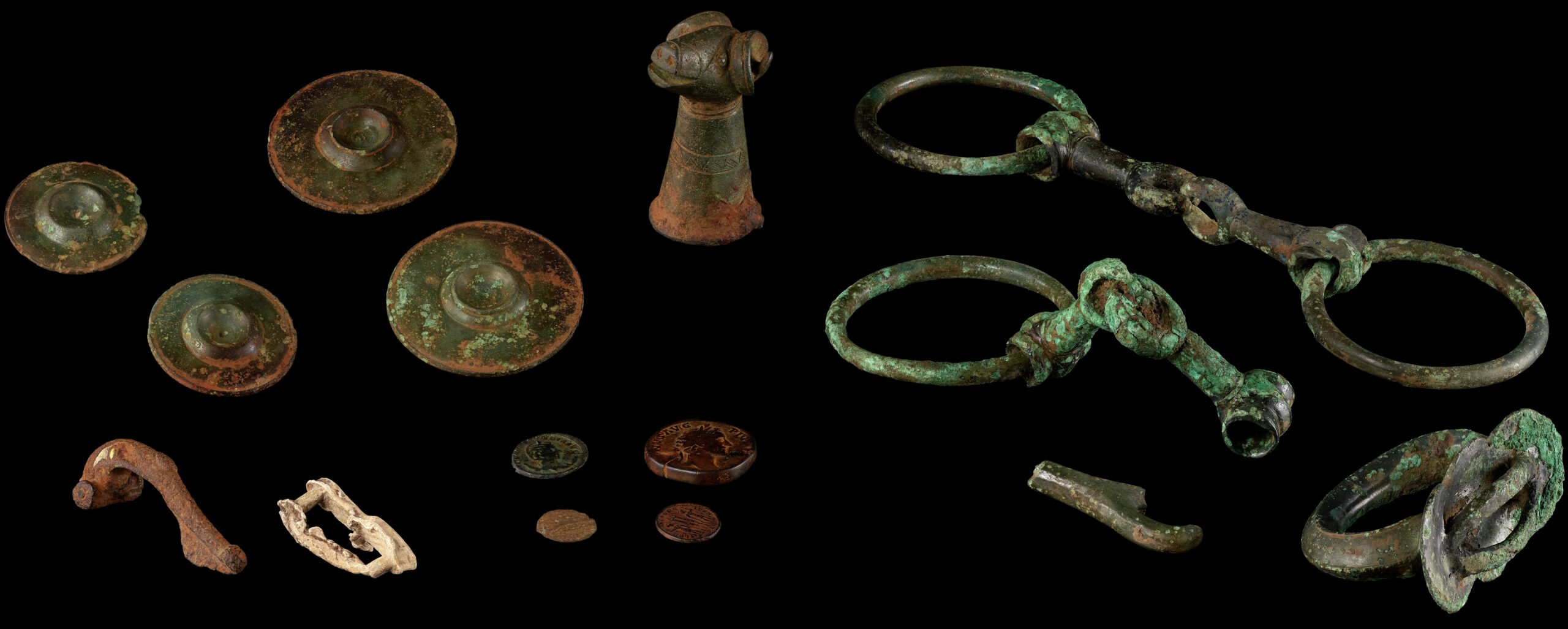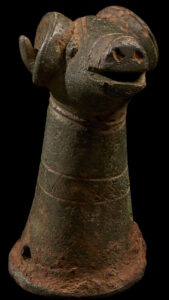A group of Iron Age bronze, copper and lead objects found near a spring in Anglesey, Wales, was declared treasure at a coroner’s inquest on Wednesday. The 16 artifacts were discovered by metal detectorist Ian Porter in two adjacent areas at two different times — some of them in March and the rest in December of 2020. They include Iron Age chariot fittings from the late 1st century A.D., Roman cavalry fittings from the same period and other metal objects from the Romano-British period.
The Roman objects are parts of three bridle bits, a terret, four phalerae (decorative discs from harnesses) and a socketed terminal shaped like a rather jovial ram’s head. There is also a large copper ingot weighing 45 pounds that was likely extracted by the Romans from the copper mine at Parys Mountain which had been mined for centuries before the Roman conquest in the 1st century. Other Roman objects in the group are a copper alloy fibula, a lead pot repair and four copper coins dating from 156-157 A.D., 260-268 A.D., 330-331 A.D. and 364-378 A.D.
The artefacts were all discovered near and around where a spring emerges in a boggy area of a modern field, liable to waterlogging. These unusual bronze, copper and lead artefacts are thought to have been gifted as repeated religious offerings around an ancient sacred spring source during the Late Iron Age and into the Romano-British period. The chariot fittings, cavalry harness pieces and brooch were all placed around AD 50-120, around the time of, or soon after the invasion of the island by the Roman army in AD 60/61. The coins and other artefacts suggest a continuing practice of votive gifting around the spring throughout the Roman period, the latest coin in the group being struck around AD 364-378. […]
Adam Gwilt, Principal Curator for Prehistory at Amgueddfa Cymru – Museum Wales said:
“This culturally mixed artefact group, containing both Iron Age chariot fittings and Roman cavalry fittings, is an important new find for the island. It was placed during or in the aftermath of the period of invasion of the island by the Roman army. This dramatic event is vividly captured by the Roman author Tacitus, writing about the strange first encounter between Roman soldiers and Druids on Anglesey. This group of gifted objects illustrates how watery locations, including the sacred lake site at Llyn Cerrig Bach, were seen as significant places for religious ceremony at this time of conflict and change.

Here’s how Tacitus describes Suetonius Paulinus first encounter with the people of Anglesey (he calls the island Mona; it is called Môn in Welsh) in The Annals XIV, 29-30:
Now, however, Britain was in the hands of Suetonius Paulinus, who in military knowledge and in popular favour, which allows no one to be without a rival, vied with Corbulo, and aspired to equal the glory of the recovery of Armenia by the subjugation of Rome’s enemies. He therefore prepared to attack the island of Mona which had a powerful population and was a refuge for fugitives. He built flat-bottomed vessels to cope with the shallows, and uncertain depths of the sea. Thus the infantry crossed, while the cavalry followed by fording, or, where the water was deep, swam by the side of their horses.
On the shore stood the opposing army with its dense array of armed warriors, while between the ranks dashed women, in black attire like the Furies, with hair dishevelled, waving brands. All around, the Druids, lifting up their hands to heaven, and pouring forth dreadful imprecations, scared our soldiers by the unfamiliar sight, so that, as if their limbs were paralysed, they stood motionless, and exposed to wounds. Then urged by their general’s appeals and mutual encouragements not to quail before a troop of frenzied women, they bore the standards onwards, smote down all resistance, and wrapped the foe in the flames of his own brands. A force was next set over the conquered, and their groves, devoted to inhuman superstitions, were destroyed. They deemed it indeed a duty to cover their altars with the blood of captives and to consult their deities through human entrails.
Oriel Môn, a museum in Llangefni less than 10 miles from the find site, is hoping to acquire the group for its permanent collection after the valuation process.
* This article was originally published here








No comments:
Post a Comment